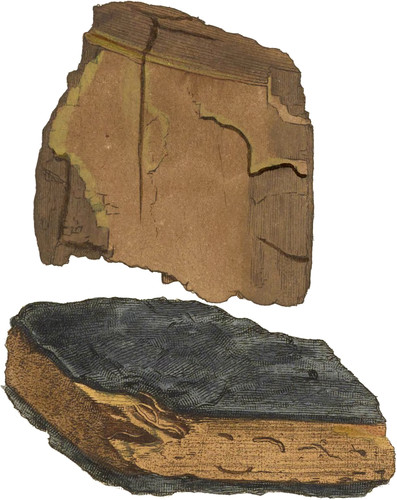 Enlarge
Enlarge
British Mineralogy
Resinous Bitumen
- Class 1. Combustibles.
- Order 3. Mixed.
- Gen. 1. Bitumen.
- Syn. Retinasphaltum. Hatchett in Phil. Trans. for 1804. 410.
After figuring the Resinous Asphaltum, I conceive it very proper to show the nature of the Wood, from the same spot, in its passage to what the people of the neighbourhood call Plank, and Bovey Coah Thus we have, by the favour of a good friend to science, obtained the Wood that may have assisted in affording this Resinous Asphaltum by a regular and gradual mineral change, depending upon the situation, depth, &c.
The upper specimen is nearly in the state in which we find very rotten wood sometimes above ground, and even in parts of living trees, with an earthy, fossil-like appearance. The grain and fracture of the wood still remain, with the fragments so sharp, that were it not for the colour and dull earthy appearance, it would seem but little altered: it is, however, so soft as to rub away under the ringer like Roman Ochre, or the brown inside of the bark of some old firs. It burns at first with a flame, then with much smoke and an odour like the Resinous Bitumen, retaining a spark for some time, almost like Touch wood.
The lower specimen is nearly of the same nature as the above, with a more rotten appearance, and so soft as to have been pierced with roots like an earth; which also sometimes happens to the rotten parts of living trees, and I have seen their ow n branches shoot roots into such decayed parts. But what is very remarkable, the two broad surfaces of this specimen have exactly the appearance of having been burnt, so as to be a perfect charcoal; and neither these fibres nor the inner part seem to have been scorched*. Mr. Hatchett remarks that “the half-charred appearance of Bovey Coal cannot be adduced as any proof that the original vegetable bodies have been exposed to the partial effects of subterraneous fire.” Now at first sight this specimen would seem to some an evidence to the contrary; but Nature coincides greatly with Mr. Hatchett, and in the general acceptation of our idea of water, there is little doubt but it has been, according to its nature, the cause of the effect here produced. We must remember that water is a very active agent, and is never quiet where there is the smallest room for its action; and as soon as the least fermentation is produced, calor or fire is evolved: and as this is continued from time to time, it is capable of producing the greatest effects. Thus the wood is formed into charcoal, slowly or otherwise, but actually by calor or fire, though water seems to be the principal agent. That this is one of Nature’s methods for some of the varieties of combustion that take place will be perhaps more and more apparent, as well as that this agent, in many instances, produces common fire, as in a haystack, &c. yet a haystack may sometimes be in part so scorched and burnt as to be spoiled, without actual or rapid fire manifested by the red heat or flame.
- * Whether either of these specimens contains the alkaline principle or not I do not known. I am happy, however, to find that Mr. Hatchett, in his Analysis of the Iceland Schistus and Bovey Coal, Phil. Trans. for 1804, p. 339, found that the alkaline principle was wanting, as I asserted to be the case in the wood-like part of Newcastle Coal. Brit. Min. tab. 100.

